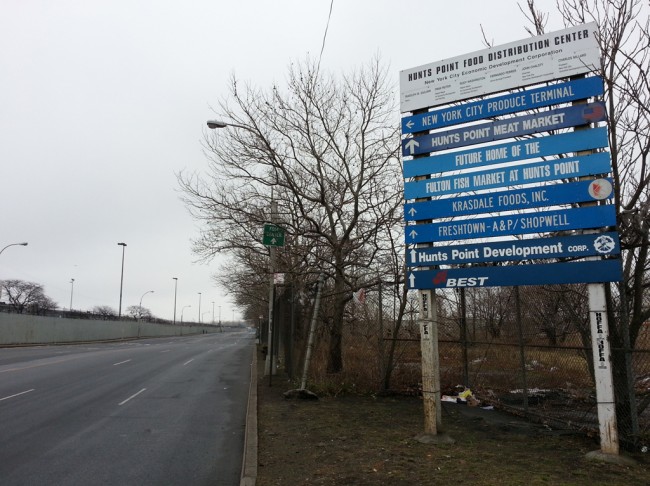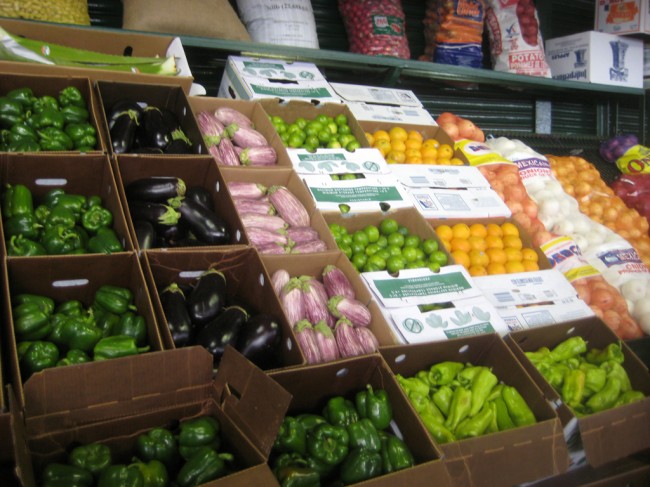
We are celebrating 15 years — and counting — of stories that are deeply researched and deeply felt, that build a historical record of what the city has been.
We are celebrating 15 years — and counting — of stories that are deeply researched and deeply felt, that build a historical record of what the city has been.

The Hunts Point Terminal Produce Market is one part of a larger food distribution hub. | Image via Matt Green
From restaurants sporting Michelin stars to Asian markets hawking star fruits, New York counts a diverse food culture among its many attractions. Despite recent studies on the potential of urban farming in the five boroughs or encouragement to “buy local,” most of the food that supplies the eateries and groceries of New York comes from far beyond the rooftops, community gardens, or hinterlands that supply your local farmers market. The central point for the collection and redistribution of a vast inventory of the city’s fruits and vegetables – providing roughly 60% of the daily stock for the city’s 8.4 million residents and feeding a total of 30 million people within the larger region – is Hunts Point Terminal Produce Market in the Bronx.
As Allison Maier of The New York World reported previously, tense negotiations between the 42-vendor cooperative that runs the market and their landlord, the New York City Economic Development Corporation, have spurred the city’s wholesale produce business to consider migrating outside city limits, most likely to New Jersey. At issue is a new lease, badly needed modernization of facilities, and the practices of the City’s Business Integrity Commission, a regulatory group that monitors industries for ties with organized crime that the vendors feel has continually overstepped its mandate in recent years. Although walking away from the negotiations means leaving $172.5 million in state and local government funding for new warehouses and other capital improvements on the table, the market’s cooperative called off talks with the City last week and intends to hold out for a better deal under the next mayor.

One of the many produce stands at the market | Image via tvancourt
Despite its unclear future, the market continues to bustle in the present, building upon a long history of the central market in New York City. Jonathan Zalman recently took a look at this history over on Narratively. He starts with the Bronx market’s forebears in Lower Manhattan:
For more than a century and a half, Washington Market, named after the country’s first president, fed New York City. The heart of the market ran along Washington Street on the west side of Lower Manhattan. … According to the official market history of the Hunts Point Terminal Produce Cooperative, the market dates to the turn of the nineteenth century. … By the mid-nineteenth century the area had become a filthy, manic health hazard and struggled to keep pace with growing demands for fresh produce. In the 1877 issue of Scribner’s Monthly, William H. Rideing noted that store owners would burn spoiled produce, such as lettuce leaves and rotten oranges, along with pieces of crating and piles of excelsior in barrels, in order to stay warm throughout the winter.
His history then shifts to the current site of the market, explaining the various infrastructural and transportation considerations that informed the location choice:
Bronx Terminal Market was erected in 1929, which made deliveries to and from Washington Market easier. In 1941, the Market was modernized yet again, but by 1956, then-City Markets Commissioner Anthony Masciarelli said that shifting produce operations to the Bronx Terminal Market was “a most logical and centrally located point for this industry,” in large part because the Major Deegan and Cross Bronx Expressways provided roadway connections to Queens and New Jersey, and there was direct railroad access for shippers. … The final death knell for Washington Market came in the form of a plan to build a massive center of commerce in Lower Manhattan. To make room for the Twin Towers, 487 produce merchants from Washington Market were offered a new home in Hunts Point, then described by The New York Times as “a marshy no-man’s land on the shores of the Bronx River.”… On March 6, 1967, the New York City Terminal Market was officially opened and America’s largest fresh fruit and vegetable wholesale distribution center was born.
The market is also a logistical spectacle. With produce coming from 49 states and 55 countries, the New York Post reports that the market manages “yearly visits by 2,200 railcars, 120,000 tractor trailers, and a million overnight buyers with small trucks and vans.” And as the goods are perishable, business must move quickly. In 2011, Urban Omnibus discussed some of the implications of supply chain logistics in a conversation with Joshua Nelson about freight rail. At the Hunts Point Terminal Produce Market, these logistics inform the design of a specific environment optimized for immense scale and necessary speed, which Zalman lays out for us:
The terminal produce market sits on 113 acres of land. Wholesale business operations occur within four main buildings—rows A through D—with the produce trade occurring along the platform floors, which run parallel to one another like the tines of a fork. The office corridors are narrow and mostly sunless, and metal doors are painted dark, separated by cool-to-the-touch off-white walls, reminiscent of a plain and impregnable detention ward. … Inside the warehouses are remarkable displays of specialized produce and processes. One Fierman Produce Exchange unit contains huge stacks of onion and potato sacks—items referred to as “hardware” because of their long shelf life—climbing nearly to the warehouse ceiling, requiring a forklift to bring them down. Inside the E. Armata tomato facility a long stainless steel machine manned by a handful of employees sorts the fruit based on their size and stage of ripening as they’re conveyed up a ridged metallic ramp.
For more on the market’s history, workers, and the points of contention in negotiations with the City, be sure to check out the full article complete with photographs of the market and its environs on Narratively. You’ll know a bit more about that banana you picked up on the corner – from Central America to your stomach, by way of the Bronx.
And to get a sense of what the market looks and feels like, check out the video below, an excerpt of “Archipelago,” which Urban Omnibus produced in 2010 as part of the Architectural League exhibition The City We Imagined / The City We Made.
The views expressed here are those of the authors only and do not reflect the position of The Architectural League of New York.